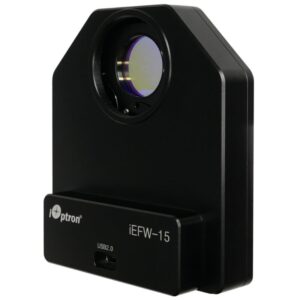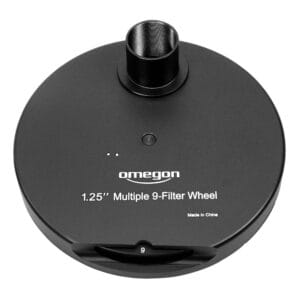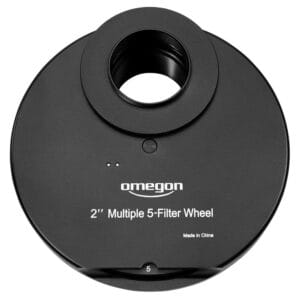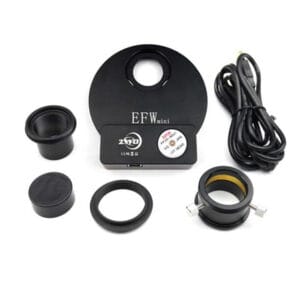Filter wheels
Switch effortlessly between filters
A filter wheel allows you to switch between LRGB or narrowband filters at lightning speed, without touching your camera or telescope. Ideal for long sessions and consistent results in astrophotography. Available in manual and motorized versions, direct from stock and delivered within 48 hours.
Showing all 11 resultsSorted by popularity
Showing all 11 resultsSorted by popularity
Complete guide: filter wheels
Filter wheels are the linchpin of your astrophotography equipment: they let you effortlessly switch between different filters without dismantling the telescope and minimize motion and alignment freezes. Whether you are working with narrowband filters (Hα, O III, S II) or with L, R, G and B filters for color photography, a quality filter wheel will save you precious night time and improve the consistency of your exposures.
1. Why a filter wheel?
Quick change
Manually changing individual filters under cold, dark skies is time consuming and prone to dust or misplacement. With a filter wheel, you change between 5-8 filters within seconds, directly from your software.Accuracy and repeatability
A good filter wheel positions each filter in the exact same spot in front of the sensor over and over again, making flat calibrations and dark frames perfectly matched.Protection of equipment
Housing your filters in one sealed ring prevents dust or moisture from getting on the optical surfaces during changes.Software Integration
Modern motor- or USB-controlled wheels can be controlled effortlessly via popular platforms such as NINA, Sequence Generator Pro or Astro Photography Tool.
2. Manual vs. motorized
| Feature | Manual Filter Wheel | Motorized Filter Wheel |
|---|---|---|
| Operation | Manual turning | Electrical via USB / serial port |
| Number of positions | 5-8 | 5-12 or more |
| Software control | No | Yes (ASCOM or INDI driver) |
| Precision | Good | Very high (stepper motor plus stoppers) |
| Price | €50-€150 | €200-€600+ |
| Weight | Light (< 200 g) | Heavier (200-500 g incl. motor) |
Tip for beginners: start with a simple manual 5-position filter wheel. For anyone running multiple narrowband sets or LRGB stacks, a motorized wheel is a must.
3. Important specifications
Filter size
Make sure the wheel fits your filters (1.25″ or 2″). Some brands provide universal half-round holders for mixed-size setups, but always check the diameter.Number of positions
The more filters you want to be able to change, the more slots you need. Popular wheels come in 5-, 7-, 8- and 10-position slots.Thickness and backfocus
Keep in mind the maximum back focus (distance between filter face and sensor). For cameras with flange distance problems, ultra-slim mounts are necessary.Control and compatibility
ASCOM drivers on Windows, INDI drives on Linux/macOS
USB power supply (5 V) or external power supply
Material and durability
Aluminum and plastic combinations offer the best balance of strength and weight. Pay attention to water and dust resistance if you operate outside a lot.
4. Assembly & Integration
Adapter plate: Most filter wheels come with a T-2 or M48 adapter to mount directly to your focuser or field flattener.
Extenders: if your wheel adds too much backfocus, use a short adapter ring instead of longer extenders.
Universal clamp: some systems offer a low weight clamp that attaches and removes wheel + camera in one motion.
5. Software workflow
Installation
Connect the wheel via USB to your laptop or observatory PC. Install the ASCOM or INDI driver.Calibration
Assign each filter position in the driver, give them labels (Ha, O III, Luminance, etc.) and save the position values.Recording Sequence
In your capture software, insert the desired filter at each sub-frame. The software switches automatically and leaves you free to fine-tune other settings (gain, exposure time).
6. Maintenance & care
Cleaning
Use anti-static, lint-free wipes and special lens cleaner. Always open the wheel out of daylight to avoid getting dust on your filters.Lubrication
For motorized wheels, periodically applying a drop of light machine oil to the shaft of the stepper motor can improve smoothness.Storage
Store the filter wheel in the supplied protective case or in a dry carrying case with silica gel bag.
7. Frequently Asked Questions
Do I work with both 1.25″ and 2″ filters?
Choose a wheel series with interchangeable holder rings so you can combine both sizes.How much backfocus loss can I have?
Usually 5-10 mm extra is acceptable. Check your system documentation for maximum tolerance.Can I also use bi-filter wheels?
Yes: they combine two filter wheels in one housing, useful if you want to run LRGB AND narrowband in parallel.











